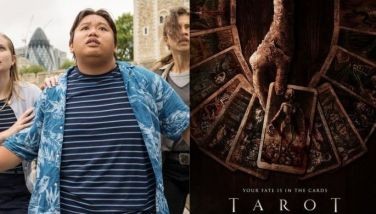The courageous 'conversion' of Christian Bautista
The conversion from a pop idol-romantic balladeer to a respected bona fide theater performer is an extremely exacting expedition. Many dreams have been cruelly crushed during the risky journey as passion and packaging are not enough to propel and sustain a legitimate stage career.
And when you are as famous and as connected as Christian Bautista, who must metamorphose into a respected bona fide theater performer — meaning one who can genuinely act, sing and dance at the same time — the pilgrimage becomes even more chancy because of the proverbial high expectation from his audience and colleagues. Failing is not part of the scenario. Or near-success acceptable.
Essaying the role of Tony, founder-leader of the violent New York youth gang The Jets, the altar boy-looking Bautista is the male lead actor in STAGES’ production of West Side Story which harnesses some of the best Filipino stage talents who have performed in critically acclaimed and financially successful musicals mounted locally as well as in Britain and in Australia. This is the main strength of this well-executed, almost clinically clean production (except for a door that closed late, one or two tolerable sound system hitches, or a missed cue among the dancers) under the magical wand of neophyte director but legitimate stage star Menchu Lauchengco-Yulo, who played Maria in the Repertory Philippines production of West Side Story also mounted at the Meralco Theater in 1981, the year Bautista was born. He turns 27 on Oct. 19.
Other members of the cast are Joanna Ampil and Karylle alternating as Maria; Gian Carlo Magdangal as Riff; Rowena Vilar and Pam G alternating as Anita; Jake Macapagal and Jeff Singson alternating as Bernardo; Jaime del Mundo as Doc; James Paolelli as Lt. Schrank; Richard Cunanan as Officer Krupke; and David Cosico as Gladhand.
The dazzling delivery of West End’s Ampil (Kim in Miss Saigon, Eponine and Fantine in Les Miserables, Mary Magdalene in Jesus Christ Superstar, Shiela Franklin in Hair, The Princess in Aladdin, and Mimi in Rent) and Australia-born Vilar (debuted in the Australian production of the Queen musical We Will Rock You, partnered with Hugh Jackman in some dance sequences in the Australian tour of The Boy from Oz, among others) have invigorated this edition of West Side Story. Both performed with the severe precision only a neurosurgeon can do, shimmering with talent grounded by discipline and professionalism sharpened by exposure to a demanding international setting. Watch their Act 2 scene A Boy Like That/I have A Love and listen as their powerful voices hit high notes sketching the pleasures, pains and in-betweens of falling in love. With this kind of performance, one misses the legendary Bituin Escalante (Dreamgirls) or the incredible Frenchie Dy (Avenue Q) in the current local stage productions. With this kind of performance, one is transported into the intensity of Michele Crider’s take on Aida at the Deutsche Oper Berlin one winter evening, right inside the Meralco Theater on an autumn-like Sunday afternoon.
But this strength in the form of a dynamic brew of talents, specifically the female ones, has this unexpected element of mutating into becoming the production’s primary pitfall. This assortment of talents inevitably shows that the best among the best ends up conquering only the mere best. It’s the classic Darwinian concept of survival of the fittest.
One wishes Bautista is as driven and as focused as Ampil, Vilar, or Daniel Radcliffe of the Harry Potter fame in becoming the best among the best. Radcliffe had reportedly said in a London-New York interview published last September, that he “took extensive acting lessons,” “did vocal exercises,” and “learned how to project” to prepare for his role as Alan Strang, the mentally troubled lead character in a London-New York revival of the ‘70s psychosexual drama Equus, which opened to critical acclaim. Tickets were also sold out. Not only did Radcliffe prepare emotionally and psychologically for his Equus role, but he plunged into a physical exercise regimen that chiseled his body for his pivotal scenes. Bautista needs more determination and experimentation to become a respected bona fide theater performer. He could have at least shaped his muscles a bit to give a coat of credibility to his characterization of gang leader Tony. A definite amount of brashness is necessary for his role as Tony. If Robin Padilla can only act, sing and dance well, he would have fit the Tony role quite convincingly. Where are the descendants these days of the Audie Gemora who awed the sharp Japanese critics with his performance in Nonon Padilla’s El Filibusterismo and Noli Me Tangere together with Monique Wilson in 1995 in Tokyo? There was the sighting of Felix Rivera in Avenue Q. And then the dearth of male talents resumed.
On the whole, STAGES’ West Side Story is a very good confidence-building measure for Bautista. It gives him the exposure and experience to be with professional stage performers in the tradition of the endangered species called “Triple Threat.” As male lead of West Side Story, Bautista has shown the theater-going public his potentials and possibilities. Remarkably, the production has also magnified the wide gap and limitations between Bautista as the pop idol-romantic balladeer and Bautista as a performer for a full-length musical. To his credit, Bautista has improved tremendously from the opening night last Sept. 5 when he was so nervous that at some point, he could be barely heard by some members of the audience seated at the back. Last Oct. 5, his ultra-careful hitting of notes was pleasant to hear, but one longs for the bravado of a Jett Pangan.
Gemora, who is now executive of the STAGES management team, may have this foreboding when he wrote: “We (together with Lauchengco-Yulo) are also the last of a vanishing breed referred to as the ‘Triple Threat’ — theater performers who can act, sing and dance. She and I have on many occasions bemoaned the fact that the generations succeeding ours no longer have strong dance backgrounds and if the discipline is not passed down, classic dance musicals like West Side Story can never be staged in the Philippines again.”
Meanwhile, West Side Story casting director Cosico also wrote: “We auditioned almost 200 musical theater actors and found eight who could sing, act, and do a clean double piroutte! This particular production was definitely an eye-opener for many of our theater artists, even some established ones, and my advice to them is: take your dance classes as seriously as your voice and acting classes. Making it in this business takes so much more than one summer in a musical theater workshop.”
Magdangal and Macapagal have commanding presence and their experience in legitimate stage was mirrored in their credible portrayal of Riff and Bernardo, respectively. It was a delight to watch them steal the audience’s attention when they joust physically and musically. Singson as Chino stood out also.
In their own ways, Del Mundo as Doc, Paolelli as Lt. Schrank, Cunanan as Officer Krupke and Cosico as Gladhand delivered commendably.
The following must be mentioned for their immense contribution in incarnating West Side Story in Manila in the 21st century: Musical director Gerard Salonga and the FILharmoniKA, set designer Mio Infante, costume designer Eric Pineda, lights designer John Batalla, sound designer Bobbit Jacinto and James Laforteza for the choreography of the restaging of the original Jerome Robbins choreography.
(E-mail comments to [email protected].)
- Latest
- Trending


























 Exclusive
Exclusive





